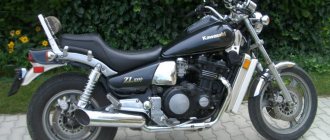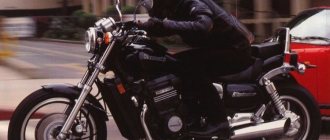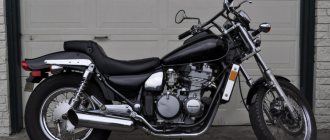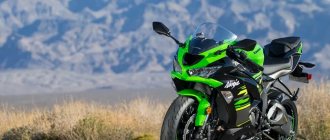- motorcycle model, Kawasaki brand,
The Kawasaki EL250 Eliminator cruiser model was first introduced in 1987 and existed on the market until 2003. Initially, the model was aimed at the domestic Japanese market, but since 1988 it has been available in the USA, and since 1990 - on the European market. In 1996, a version of the Kawasaki EL252 Eliminator was produced for European countries, which had a 252 cc engine. cm instead of the standard 248 cc. cm.
The model was based on an in-line 2-cylinder liquid-cooled engine producing 40 hp. power and almost 24 Nm of torque. Modifications of this engine were also installed on the Kawasaki GPZ250, Kawasaki ZZ-R250 and Kawasaki KLE 250 models. Standard European versions produced up to 33 hp. power.
Other features of the Kawasaki EL250 Eliminator include a steel frame, simple suspension in the form of a conventional telescopic fork and a double shock absorber, front disc and rear drum brakes, a 6-speed gearbox, an 11-liter fuel tank and 134 kg of dry weight.
Main modifications of the Kawasaki EL250 Eliminator:
Kawasaki EL250 Eliminator - regular version.
Kawasaki EL250 Eliminator SH - version is similar to the previous one. Export oriented.
Kawasaki EL250 Eliminator SE - version with semi-fairing and lower plow.
Kawasaki EL250 Eliminator LX is a classic version with spoked wheels.
Kawasaki EL252 Eliminator - version for some European countries. Similar to the previous version, but with a 252 cc engine. cm.
Japanese versions of the Kawasaki EL250 Eliminator were available on the market until 1998, European versions until 2003. By 1998, Kawasaki updated the EL250 Eliminator to the VN250 Eliminator, offering the market a cruiser with more familiar classic shapes and a V-twin engine, finally moving away from the power concept -cruisers of the 80-90s.
Exterior design of the sportbike
The Kawasaki Ninja 600 has an impressive appearance with a sporty style.
The first thing that catches your eye in the foreground are the high-brightness dual headlights.
The style is also complemented by the Ram Air air intake system, which is placed in the center of the bike.
Turn signals are built into the front fairing.
The wing at the front has acquired an aerodynamic shape.
At the rear, the turn signals are quite small and cone-shaped. The rear light is equipped with bright LEDs.
It precisely projects the shape of the rear fairing and is located high above the road level, which ensures maximum visibility of the motorbike on the road.
The instrument panel is made in a racing style and consists of:
- Gear adjustment indicator.
- Digital speedometer.
- Diagram tachometer.
- Digital thermometer.
- Stopwatch.
- Watch.
- Indicator lamps.
- Odometer.
In addition, it can be noted that the exhaust system is made of stainless steel. The sporty style is reflected in the passenger footrests.
The mounting panel was made in the form of a triangle with special cutouts. The bike frame has a black finish.
Model history
1987 - start of production and sales of the Kawasaki EL250 Eliminator model. Model: Kawasaki EL250 Eliminator (Japan). Factory designation: EL250-B1.
1988 - appearance of the SE modification. The model is officially sold in the USA. Model: Kawasaki EL250 Eliminator / SE (Japan, USA). Factory designation: EL250-B2, EL250-A2 (SE).
1989 - appearance of the LX modification. Model: Kawasaki EL250 Eliminator / SE / LX (Japan, USA). Factory designation: EL250-B3, EL250-A3 (SE), EL250-C1 (LX).
1990 - model sold in Europe. The regular version is no longer offered in Japan. Model: Kawasaki EL250 Eliminator SE/LX (Japan, Europe). Factory designation: EL250-A4 (SE), EL250-C2 (LX).
1991 - Japanese versions are no longer produced. Model: Kawasaki EL250 Eliminator SH (USA, Europe). Factory designation: EL250-E1.
1992 - no significant changes. Model: Kawasaki EL250 Eliminator SH (USA, Europe). Factory designation: EL250-E2.
1993 - resumption of production in Japan. The model is also sold in Canada. Model: Kawasaki EL250 Eliminator SH/LX (North America, Europe, Japan). Factory designation: EL250-C3 (LX), EL250-E3 (SH).
1994 - no significant changes. Model: Kawasaki EL250 Eliminator SE/SH/LX (North America, Europe, Japan). Factory designation: EL250-A5 (SE), EL250-C4 (LX), EL250-E4 (SH).
1995 - model not produced. 1996 - the appearance of a new European version of the EL252 Eliminator. Model: Kawasaki EL250 Eliminator SE/LX/252 (North America, Europe, Japan). Factory designation: EL250-A6 (SE), EL250-C6 (LX), EL250-F2 (252), EL250-D7.
1997 - Only a new European version of the EL252 Eliminator is produced. Model: Kawasaki EL252 Eliminator (Europe). Factory designation: EL250-F3.
1998 is the last year of production of the Japanese version of the EL250LX Eliminator. This year's models feature a silver color. It is being replaced by a completely new model - the Kawasaki VN250 Eliminator. Model: Kawasaki EL250 Eliminator LX (Japan). Factory designation: EL250-C8.
1999 - Only the European version of the EL252 Eliminator is produced. Model: Kawasaki EL252 Eliminator (Europe). Factory designation: EL250-F4.
2000 - model not produced. 2001 - no significant changes. Model: Kawasaki EL252 Eliminator (Europe). Factory designation: EL250-F5.
2002 - model not produced. 2003 is the final year of production of the Kawasaki EL252 Eliminator. Model: Kawasaki EL252 Eliminator (Europe). Factory designation: EL250-F6.
Popular opinion
It is unlikely that any of the owners of the fast and powerful Kawasaki Ninja 1000, when describing their horse, will use epithets such as “calm”, “balanced”, “flexible” and “quiet”. Most likely, it will be just an explosion of emotions using expressive language and a few exclamation marks.
Someone put it very well about the 2004 model: “This motorcycle is simply created for crazy people. “Kawasaki Ninja 1000” doesn’t give anyone a warning slap in the face – it hits clearly and immediately.”
Nevertheless, in just a few years, the ZX-10R has become an incredibly popular model, which has been adopted by both experienced and completely “green” bikers. Dynamic design in a futuristic style, streamlined body and decent technical characteristics - all these are prerequisites for the popularization of this model.
Characteristics:
| Model | Kawasaki EL250 Eliminator |
| Motorcycle type | cruiser |
| Year of manufacture/sales | 1987-1998 (2003) |
| engine's type | 2-cylinder, 4-stroke, in-line |
| Working volume | 248 cc cm 252 cc see - EL252 Eliminator (Europe) |
| Cooling | liquid |
| Bore/Stroke | 62.0 x 41.2 mm 62.5 x 41.2 mm — — EL252 Eliminator (Europe) |
| Compression ratio | 12.0:1-12.4:1 (depending on version) |
| Number of valves per cylinder | 4 valves per cylinder (DOHC) |
| Fuel supply system | carburetor, x2 Keihin CVK30 |
| Ignition type | fully transistorized |
| Maximum power | 40 hp (29.4 kW) at 12500 rpm 33 hp. (24.1 kW) at 12500 rpm - European versions |
| Maximum torque | 23.5 Nm at 10,000 rpm 20.0 Nm at 10,000 rpm - European versions |
| Transmission | 6-speed |
| type of drive | chain |
| Frame | steel tubular |
| Front suspension | telescopic fork 36 mm, travel - 140 mm |
| Rear suspension | pendulum with two shock absorbers, stroke - 100 mm |
| Front tire size | 100/90-17 55S |
| Rear tire size | 140/90-15 70S |
| Front brakes | 1 disc 260 mm, 1-piston caliper |
| Rear brakes | drum, 160 mm |
| Dimensions (L x W x H) | 2140 x 745 x 1110 mm - SE 2140 x 665 x 1045 mm - LX |
| Seat height | 700 mm - SE 725 mm - LX |
| Wheelbase | 1490 mm |
| Gas tank capacity | 11.0 l |
| Maximum speed | 155 km/h - Japanese versions 139 km/h - European versions |
| Acceleration to 100 km/h | 7.0 sec - Japanese versions 8.2 sec - European versions |
| Motorcycle weight (dry) | 134 kg - regular version 142 kg - LX 143 kg - SE |
| Motorcycle weight (curb) | 152 kg - regular version 158 kg - LX 159 kg - SE |
Transmission
The basic package is also characterized by the fact that it includes the installation of a clutch made using racing motorcycle technologies.
The slipper clutch controls rear wheel slip during heavy engine braking at high speeds, making riding safer and more comfortable.
In addition, this type of clutch has a softer clutch lever when pressed.
The motorcycle transmission, as it was, remained six-speed. However, a very useful function has been added to its operation - automatic engagement of neutral gear when the motorcycle stops.
KIMS
The system works as follows: the on-board computer monitors the readings of all sensors directly, combining them into one picture. This happens every 200th of a second. Thanks to the information received, the computer receives information about what is currently happening on the road. In fact, the system predicts the pilot's future behavior.
The work of the on-board computer is aimed at preparing the motorcycle for further changes. If the pilot wants to slide, the motorcycle will do it. What this means is that if you put it in first gear as you exit a tight, tight corner, you can get yourself a ticket to a show where the bike falls on its side and the rider is catapulted straight to the hospital with a broken pelvis.
To prevent this from happening, you need to understand that full throttle is an order for the motorcycle to activate all its power and strength. There is no point in experimenting with the clutch system - this is the prerogative of professional racers, whose fifth point is insured, and for rides there is a special track with an impact fence.
Leaving a Honda Fireblade in the dust
At the races in Qatar, along with the Kawasaki ZX-10R, another superbike, the 2007 Honda Fireblade, was presented. Nevertheless, “Kava” pulled up its opponent, leaving the no less famous Blade behind. This is especially true for the tachometer - as soon as you cross the cherished mark, the green stallion rapidly rushes forward, quickly turning into a point on the horizon.
Much of the credit for this, of course, goes to the engine. But there is one more “but” - this is a special wheel-road traction system, which is called KIMS (Kawasaki Ignition Management System). It’s worth avoiding all the marketing fluff and explaining the principle of operation in simple words. You can immediately note that this is not the wheel-road traction system itself - there are not enough special wheel speed sensors for this. Besides, the motorcycle will still slide. And the rear wheel will carry away when you sharply release the gas when cornering. And you can fly off the road at high speed.
But the unique Kawasaki Ignition Management System, which deserves special attention, helps to avoid all this.
Peculiarities
The first thing that attracts attention is management. Steering the bike is very comfortable, which is facilitated by the wide handlebars, proportions, and classic vertical landing.
In addition, the motorcycle is stable and has a smooth ride. The brakes are also excellent, the front disc does its job fully, and in severe cases it is helped by the rear drum.
The main feature of the “eight hundred” is its engine. The operating figures are almost identical to those of the 650, but at the same time the engine is much more torquey and quieter, and has lower operating and maximum speeds. In other words, at medium and low speeds it will “pull” well even in high gears.
The design is also top-notch – a ribbed saddle, wheels with thick spokes, a lowered steering wheel, and exhaust trims. All parts are either chromed or lacquered, which, combined with the restrained color scheme and overall layout, creates the impression of a real British retro of the mid-20th century.
The instrument panel combines classic and modern: an analogue tachometer and speedometer are adjacent to an LCD screen displaying the tripmeter, clock and odometer. Also on the panel are “flashing lights” for turns and neutral, and an oil indicator.
Suspension and braking system
The 2006 model features an improved suspension, thanks to which the bike confidently plows not only smooth trails, but also second-rate roads with holes, humps and potholes. The previous version could cause serious fear in such conditions (as if the engine had not done this before!).
Front 4-piston calipers, which literally bite into two discs with a diameter of 300 mm, are more effective, although they require the use of considerable force. The rear brake responds more readily to the pilot's wishes. Of course, at that time, installing reinforced brake hoses is the optimal solution for this model. The updated model has acquired a pointed tail, under which a dual exhaust is successfully hidden. This, by the way, had little effect on the turbulence of the model.
Relatively small lens headlights with a “tear-shaped” shape and a powerful air intake capable of sucking in a crow appealed to all those who considered the first model too simple and characterless. An attractive highlight is the LED rear brake light and turn indicators.
Chassis
The motorcycle is comfortable and easy to ride, both in urban conditions and on the highway.
The only disadvantages are that at maximum speed the fairings work well only if the driver is pressed against the tank, and that due to the light weight and high side windage of the body kit, the bike is sensitive to side gusts of wind.
Ride comfort is also ensured by the Uni Track rear single-link suspension with a manually adjustable variable stiffness shock absorber.
A comfortable anatomically shaped seat and adjusted distance to the steering wheel allows the motorcyclist to take an almost classic riding position, which contributes to comfortable trips over long distances.
The chassis has changed little, only the front fork settings have changed.
Slightly wider wheels, and the Ninja 300 has 110/70 and 140/70 wheels, respectively, front and rear with a diameter of 17 inches, contribute to more stable behavior of the motorcycle in corners.
Optionally, the motorcycles come with an anti-lock brake system, which adds little to the price of the motorcycle, but is fully justified when driving on slippery surfaces.
A modified panel allows you to control the operating modes of the power unit and the movement of the motorcycle. The panel provides digital speedometer, tachometer, day and trip meters, clock and environmental indicator for monitoring.
Brake system
The brake discs are large here. Their width is 6 mm and diameter is 300 mm. They are made of stainless steel.
Thus, the brake force will be very strong each time you apply them.
It often happens that even experienced riders find it difficult to discern which gear is currently in use while riding.
To prevent such situations, the digital display is installed in a large size.
It is able to instantly display all the most important information for the rider - speed and gear number.
The ZX-6R model has cylindrical airbox guides. They help ensure accurate spraying from the fuel injectors.
As a result, better fuel atomization improves combustion efficiency. Accordingly, the engine output will be greater.
Power and top speed of the Kawasaki Ninja 1000
The 998 cm3 four-cylinder engine generates 175 hp. s., which is achieved at 11,700 rpm. The numbers look very nice, especially considering that the weight of the motorcycle is not very large - only 170 kg. But that's not what's shocking. What's amazing is how the Kawasaki Ninja ZX-10R delivers this power.
In order to really imagine this, it is enough to imagine the following: a presentable restaurant, a client orders partridge stewed in a noble manner and a bottle of exquisite wine from the waiter. Garcon, instead of serving the dish on a golden tray decorated with lush greens and baked apples, throws a partridge in the guest’s face and breaks the bottle on his head. The ZX-10R develops its power approximately this way.
In 2006, an updated model was introduced, which became softer and more flexible. Although, probably, in this case, the new thing looked like a mad tiger after a week-long hunger strike, feasting on yogurt. “Kava” remained just as sharp and piercing. But at the same time, other indicators have improved - the stability of the motorcycle at high speed and second-rate roads has increased. In addition, an Ohlins steering damper has appeared, which is very good for owners. After all, it used to be the very first thing on the list of necessary purchases.
The developers claim that the Kawasaki Ninja 1000 motorcycle is very friendly. Can this statement be true if the ZX-10R is in Power Wheelie position in third gear at mid-range RPM? Let it remain on their conscience.








